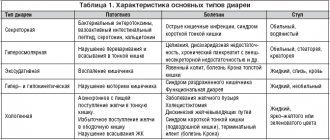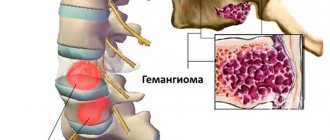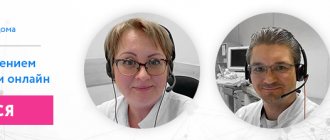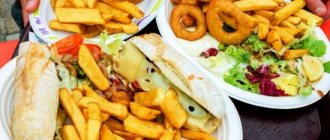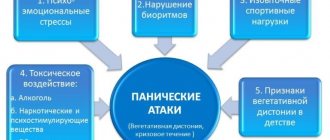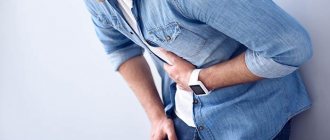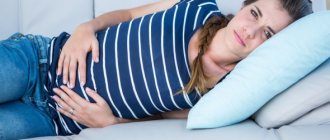What is hepatic colic
Hepatic colic is a pathological condition in which acute pain occurs in the right hypochondrium. The duration of the attack varies depending on the reason for which it occurred. Initially, the first attacks usually last 15-20 minutes, in advanced cases up to 5-6 hours.
According to statistics, renal colic occurs more often in people over 40 years of age, preferably in men.
To understand why the liver colitis and how the attack occurs, you need to know the structure and functions of the organ. The liver is a gland that belongs to the digestive system of the body, but it also takes part in various metabolic processes. In structure, it consists of lobules, which are connected to each other by vessels and ducts.
The main functions of the body are:
- metabolism - protein breakdown, glycogen synthesis, metabolism of fats, hormones, vitamins;
- detoxification – neutralization of toxins;
- bile synthesis.
Due to poor nutrition, chronic diseases, and other reasons, metabolic processes in the body are disrupted. Fat begins to accumulate on the walls of the liver, foci of inflammation appear, and the integrity of the organ tissues is compromised. One of the first manifestations of these pathological changes is colic.
Pain in the right hypochondrium can be periodic or constant. Usually a person wants to bend over or lie on his side with his knees bent - relief is felt in such body positions. Colic can appear after eating, especially heavy food, alcohol, or physical activity. In case of serious liver pathologies, they continue for a long time.
Causes
Often colic occurs due to disturbances in the outflow of bile. This substance is produced by the liver, then passes through the ducts into the gallbladder, then into the digestive tract. After eating, bile is activated and takes part in the processes of food digestion. When obstacles appear in the path of bile - stones, an acute inflammatory process begins. Therefore, cholelithiasis (cholelithiasis) is considered one of the main causes of colic.
When stones, moving along with bile, enter the ducts, they injure their walls. The pressure inside the gallbladder increases as it works harder to push out the stones. In this case, the bile, which was produced in the liver at this time, cannot move further and is retained in it. As a result of the irritating effect of stones in cholelithiasis, acute pain appears in the right hypochondrium.
In more than 70% of cases, the cause of severe colic in the liver is stone formation in the gallbladder and the consequences that arise from it.
Other reasons are the following pathological conditions:
- biliary dyskinesia;
- giardiasis, other parasitic lesions of the gastrointestinal tract;
- inflammation of the ducts;
- congenital anomalies of the biliary tract.
As for congenital anomalies, they can appear both in young children and as they grow older, it all depends on the nature of the pathology.
Causes due to human fault
Sometimes a person’s lifestyle becomes the main reason for the development of cholelithiasis and, as a result, the occurrence of hepatic colic.
Why does my liver hurt after drinking alcohol?
Provoking factors may be:
- alcohol abuse (sometimes consequences in the form of liver damage appear years later);
- consumption of fatty, fried, other unhealthy foods, fast food;
- following a diet with excessive restrictions, for example, a mono-diet;
- starvation;
- sudden weight loss/gain;
- heavy physical activity;
- severe stress.
Fact. In women, the process of stone formation can occur due to disruptions in the menstrual cycle and other hormonal disruptions that occur due to metabolic disorders.
Diagnostics
To correctly diagnose the disease and prevent the recurrence of pain, it is necessary to carefully study the history and conduct additional examination. First, the doctor asks the patient about the clinical symptoms that bother him, as well as the characteristics of their appearance and progression.
Particular importance should be given to information about past illnesses, chronic pathology, the presence of similar attacks previously, as well as the nature of nutrition and alcohol abuse. With cholelithiasis, episodes of colic gradually become more frequent, longer and more intense.
Pathology of the biliary tract is indicated by the appearance of pain in the area of the right hypochondrium after errors in diet, heavy exercise or drinking alcohol.
The patient may also be bothered by nonspecific signs of digestive dysfunction, such as nausea, bitterness in the mouth, bloating and heaviness in the gastric region.
During a physical examination, the doctor focuses on a slight yellowness of the skin and mucous membranes, which indicates stagnation of bile. To reduce pain, the patient lies down on the couch and takes a position with his knees brought to the chest. When trying to palpate the abdomen, tension in the abdominal wall is noted as a protective reflex.
To confirm the diagnosis, an ultrasound examination is prescribed, which allows you to examine the hepatobiliary tract (biliary tract, liver). The doctor detects stones, notes an increase in the size of the bladder and stretching of the walls.
During cholecystography, a contrast agent is administered intravenously. Thus, the specialist visualizes a “disabled” bladder, which confirms the presence of obstruction in the ducts.
During laboratory diagnostics, an increased ESR and an increase in leukocytes are detected. After an attack, bile pigments can be detected in the urine, which indicates the development of jaundice. Sometimes there is an increase in amylase.
Differential diagnosis should be carried out with acute acalculous cholecystitis, renal colic, intestinal spasm, inflammation of the pancreas, appendicitis and gastric ulcers.
Symptoms
The main symptom of the pathology is acute pain. Often a person notices that the liver tingles immediately after eating, but after a while the condition returns to normal. If colic is caused by cholelithiasis, this frequency of attacks is explained by the movement of stones. First, the stone got stuck in the duct, which caused pain, then either returned back to the gallbladder, or was pushed further.
There are also other signs by which hepatic colic can be recognized. These include:
- Digestive system disorders. A person experiences an upset stomach, more often with diarrhea, flatulence, nausea, and vomiting. Moreover, during vomiting, bile comes out, and there is no relief after it.
- Pain syndrome affecting other parts of the body. It can affect the right arm, shoulder, shoulder blade. With such intense pain, changing body position does not bring relief.
- Yellowing of the skin. If colic is associated with stone formation in the gallbladder, the manifestation of bile stagnation is visible in the icteric tint of the skin.
Yellowing of the skin is a symptom of a severe form of pathology and indicates the need for urgent medical attention.
Hepatic colic can be recognized in these symptoms after diagnostics, which include ultrasound of the abdominal organs, cholecystography, and, if necessary, other studies as prescribed by the doctor.
Features of manifestation in men and women
Symptoms of hepatic colic are similar in women and men. The treatment is the same for both sexes. A special feature is that in women, colic can occur during pregnancy, which is associated with an enlarged uterus and its pressure on the abdominal organs. As a result, the pressure inside the gallbladder increases, which affects the functioning of the liver.
As for men, a common cause of cholelithiasis and, as a consequence, colic, is alcohol abuse. According to statistics, every fourth representative of the stronger sex has a tendency to this bad habit. Because of this, colic occurs against the background of heart problems and other complications caused by alcohol abuse.
Symptoms of an acute attack
The tingling sensations during an attack can increase intensely, and the person’s condition worsens before our eyes. Usually at this time a person lies down, but cannot find a comfortable position, so he rushes around the bed. Spasms can be of different types:
- cutting;
- pricking;
- tearing
Irradiation of pain to the right shoulder blade, arm, shoulder worsens the condition. Painful sensations can affect the left hypochondrium and resemble an angina attack. The body temperature rises to 37 degrees, the person breaks into a sweat. Pain relief with conventional painkillers will not always be effective, so during an attack the patient should be examined by a doctor and prescribed.
If the symptoms worsen: body temperature rises to 38-39 degrees, pronounced yellowing of the skin appears, vomiting is indomitable, this indicates the development of complications. Often it turns out to be acute cholecystitis. Knowing what to do at the first manifestations of colic, you can prevent the onset of such complications.
Features of manifestation in men and women
If we compare the clinical picture of biliary colic in opposite sexes, there are no definite differences. One has only to note that in women, pregnancy can provoke colic, which is associated with displacement of internal organs due to an enlarged uterus.
In turn, a man is more difficult to tolerate dietary restrictions, and therefore more often violates medical recommendations for diet therapy. As a result, both an attack of colic and inflammation of the gallbladder can occur. In addition, alcohol plays an important role, the abuse of which is more common among men.
How to relieve hepatic colic - first aid
While waiting for the doctor to arrive, the patient can receive emergency care at home. The main task is not to aggravate the person’s condition or increase the pain syndrome. It is strictly prohibited:
- apply a heating pad to the right hypochondrium;
- engage in any activities, physical activity is contraindicated during an attack;
- press on the area with painful sensations;
- eat food, drinks, it is only allowed to drink clean water in small quantities;
- take any medications whose effectiveness is not certain.
The help algorithm is as follows:
- Provide the patient with rest. He should lie either on his back or on his right side. There is no need to force him to lie in a way that is uncomfortable for him. It is better to be in a quiet, calm environment.
- Use an antispasmodic. Papaverine, No-Shpa, Promedol are considered effective. To relieve spasms faster, it is better to give an injection based on these drugs rather than take them orally.
- Provide fresh air. The patient must breathe calmly so that the nervous system calms down.
Usually, a gastroenterologist diagnoses and prescribes treatment for hepatic colic; if the attack is not severe, you can take the patient to the clinic on your own
Then you just have to wait for the doctor or ambulance to arrive. In most cases, acute attacks require hospitalization in order not only to relieve hepatic colic, but to establish its cause and select effective therapy.
Treatment
Colic can be treated only after the cause of its occurrence has been established. If the attacks are acute and the patient's condition is critical, hospitalization is required. First of all, the attending physician prescribes:
- absolute rest, restriction of movements for a day;
- fasting (from several hours to a day);
- the use of antispasmodics and analgesics to relieve acute pain.
After establishing a diagnosis and providing first aid, complex therapy is prescribed. It includes the use of medications and diet.
Medication
The most common cause of colic is urolithiasis; in such cases, drug treatment is prescribed, which includes the use of drugs that help remove stones. This can be done when their sizes are small.
If the stones reach 1.5 cm or more, surgical intervention is required; stone crushing with ultrasound has recently become popular.
First of all, medications that relieve spasms are prescribed - non-steroidal analgesics, which are administered intravenously or intramuscularly. After the acute pain has passed, you can continue taking them in tablet form. If the pain is unbearable, opiates are prescribed, but only for a short time and under the supervision of a doctor.
For colic, the non-steroidal painkiller Revalgin is often prescribed.
If the cause of colic is cholelithiasis, the following are prescribed:
- Allohol and its taxes (with choleretic effect);
- Ursosan;
- No-Shpa, other antispasmodics;
- Cyclovalon and other choleretic drugs with anti-inflammatory effects.
Treatment of other diseases that provoke hepatic colic is prescribed individually. Surgery is almost always required for congenital abnormalities of the liver, gallbladder or ducts that cause the disease.
Diet therapy
Diet No. 5 is usually prescribed, which complements drug treatment or is used after surgery during the rehabilitation period.
Its main principles are:
- exclusion from the diet of fatty, fried foods, smoked, spicy, salty, fast food;
- consumption of dairy products only with a low percentage of fat;
- exclusion of flour, baked goods, sweets, chocolate;
- refusal of coffee, strong tea, alcohol;
- daily consumption of at least 1.5-2 liters of clean water;
- eating small portions 4-6 times a day.
At first, the dishes should be pureed, as liquid as possible, then other products should be gradually introduced
To regulate the outflow of bile and normalize the production of this substance by the liver, at first you may need a more restrictive diet. If a patient is admitted to the hospital with an acute attack, fasting is prescribed, then foods are introduced into the diet gradually. Therefore, nutritional recommendations are individual in each case.
Possible complications
When the lumen of the biliary tract is completely obstructed by a large stone, obstructive jaundice develops. Clinically it manifests itself:
- discoloration of stool;
- itching;
- darkening of urine;
- yellowness of the skin and mucous membranes. Its severity can reach an orange tint.
Laboratory tests reveal an increase in the level of total bilirubin and its direct fraction in the blood. Bile pigments are detected in the urine. Using ultrasound, it is possible to visualize the calculus and assess the extent of damage to the bladder and ductal system.
After surgical removal of the stone, bile flow is restored, and the signs of jaundice regress.
Another complication is peritonitis. The mechanism of its development is as follows:
- obstruction of the duct with a large stone;
- spasm of the biliary tract;
- disruption of nutrition in the wall on which pressure is exerted by the stone;
- tissue necrosis;
- violation of the integrity of the wall;
- penetration of bile into the abdominal cavity.
Prevention
In most cases, hepatic colic and the urolithiasis that precede it can be prevented. To do this, it is recommended to follow the following preventive measures:
- limit the consumption of fatty foods, especially those containing cholesterol;
- choose lean varieties of meat and fish;
- limit your consumption of sweets, give up starchy foods;
- add fresh, boiled, baked, stewed vegetables and fruits to your daily diet;
- All dishes should be boiled, stewed or baked; frying is prohibited;
- to refuse from bad habits;
- play sports, walk daily;
- avoid excessive physical activity and heavy lifting;
- maintain normal weight, avoid fasting and overeating;
- if you suspect any disease of the gastrointestinal tract, immediately consult a gastroenterologist;
- timely treat any diseases of the gallbladder, liver, including maintaining health in chronic diseases;
- undergo a comprehensive medical examination annually.
Compliance with these rules will help prevent many diseases of the digestive system and other internal organs.
The pain syndrome that occurs with hepatic colic is considered one of the most severe. At first, it may be moderate and it is important to immediately go to the hospital in order to identify the cause in time, make a diagnosis and choose treatment. If a severe attack of acute pain occurs, you should urgently call an ambulance and provide first aid at home. In critical cases, emergency surgery may be required.
Diet
Regardless of the choice of treatment tactics, a conservative or surgical method, an integral part of the therapy is a dietary regimen. This diet allows you to reduce the load on the hepatobiliary tract and facilitate bile outflow. In turn, this prevents changes in the composition of bile and the process of stone formation.
Basic principles of diet No. 5:
- complete abstinence from alcoholic beverages, including low-alcohol ones;
- exclusion of fatty milk, meat and fish products;
- a ban on hot seasonings, marinades, smoked foods, pickles and canned food;
- refusal of fresh baked goods, cream products and chocolate;
- exclusion of coffee;
- a ban on legumes, mushrooms, and products with oxalic acid.
The diet should consist of:
- low-fat foods;
- vegetables;
- yesterday's baking;
- various porridges from buckwheat, oatmeal, pasta or rice;
- egg whites;
- soups, low-fat broths;
- biscuits.
Every day you need to drink at least two liters of weak green tea, still mineral water, jelly or diluted juice. The amount of salt per day is limited to 7 grams. Meals should be fractional, small portions. Therefore, it is recommended to eat every two hours. This makes it possible to regulate bile flow and prevent stagnation.
Dishes should have a puree-like consistency. Cooking is carried out using steam, by boiling or baking.
After surgery, only liquid is allowed on the first day. Then the diet gradually expands to include pureed foods. Provided the postoperative period is normal, the patient is transferred to diet No. 5, which must be followed for life.
